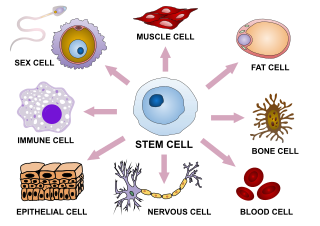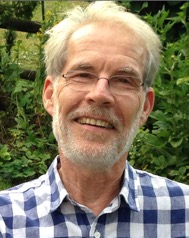Related Research Articles
Transdifferentiation, also known as lineage reprogramming, is the process in which one mature somatic cell is transformed into another mature somatic cell without undergoing an intermediate pluripotent state or progenitor cell type. It is a type of metaplasia, which includes all cell fate switches, including the interconversion of stem cells. Current uses of transdifferentiation include disease modeling and drug discovery and in the future may include gene therapy and regenerative medicine. The term 'transdifferentiation' was originally coined by Selman and Kafatos in 1974 to describe a change in cell properties as cuticle producing cells became salt-secreting cells in silk moths undergoing metamorphosis.

Cellular differentiation is the process in which a stem cell changes from one type to a differentiated one. Usually, the cell changes to a more specialized type. Differentiation happens multiple times during the development of a multicellular organism as it changes from a simple zygote to a complex system of tissues and cell types. Differentiation continues in adulthood as adult stem cells divide and create fully differentiated daughter cells during tissue repair and during normal cell turnover. Some differentiation occurs in response to antigen exposure. Differentiation dramatically changes a cell's size, shape, membrane potential, metabolic activity, and responsiveness to signals. These changes are largely due to highly controlled modifications in gene expression and are the study of epigenetics. With a few exceptions, cellular differentiation almost never involves a change in the DNA sequence itself. However, metabolic composition does get altered quite dramatically where stem cells are characterized by abundant metabolites with highly unsaturated structures whose levels decrease upon differentiation. Thus, different cells can have very different physical characteristics despite having the same genome.

Oct-4, also known as POU5F1, is a protein that in humans is encoded by the POU5F1 gene. Oct-4 is a homeodomain transcription factor of the POU family. It is critically involved in the self-renewal of undifferentiated embryonic stem cells. As such, it is frequently used as a marker for undifferentiated cells. Oct-4 expression must be closely regulated; too much or too little will cause differentiation of the cells.

Adult stem cells are undifferentiated cells, found throughout the body after development, that multiply by cell division to replenish dying cells and regenerate damaged tissues. Also known as somatic stem cells, they can be found in juvenile, adult animals, and humans, unlike embryonic stem cells.
The epithelial–mesenchymal transition (EMT) is a process by which epithelial cells lose their cell polarity and cell–cell adhesion, and gain migratory and invasive properties to become mesenchymal stem cells; these are multipotent stromal cells that can differentiate into a variety of cell types. EMT is essential for numerous developmental processes including mesoderm formation and neural tube formation. EMT has also been shown to occur in wound healing, in organ fibrosis and in the initiation of metastasis in cancer progression.
Douglas A. Melton is an American medical researcher who is the Xander University Professor at Harvard University, and was an investigator at the Howard Hughes Medical Institute until 2022. Melton serves as the co-director of the Harvard Stem Cell Institute and was the first co-chairman of the Harvard University Department of Stem Cell and Regenerative Biology. Melton is the founder of several biotech companies including Gilead Sciences, Ontogeny, iPierian, and Semma Therapeutics. Melton holds membership in the National Academy of the Sciences, the American Academy of Arts and Sciences, and is a founding member of the International Society for Stem Cell Research.

Induced pluripotent stem cells are a type of pluripotent stem cell that can be generated directly from a somatic cell. The iPSC technology was pioneered by Shinya Yamanaka and Kazutoshi Takahashi in Kyoto, Japan, who together showed in 2006 that the introduction of four specific genes, collectively known as Yamanaka factors, encoding transcription factors could convert somatic cells into pluripotent stem cells. Shinya Yamanaka was awarded the 2012 Nobel Prize along with Sir John Gurdon "for the discovery that mature cells can be reprogrammed to become pluripotent."

Fms-related tyrosine kinase 3 ligand (FLT3LG) is a protein which in humans is encoded by the FLT3LG gene.

PDX1, also known as insulin promoter factor 1, is a transcription factor in the ParaHox gene cluster. In vertebrates, Pdx1 is necessary for pancreatic development, including β-cell maturation, and duodenal differentiation. In humans this protein is encoded by the PDX1 gene, which was formerly known as IPF1. The gene was originally identified in the clawed frog Xenopus laevis and is present widely across the evolutionary diversity of bilaterian animals, although it has been lost in evolution in arthropods and nematodes. Despite the gene name being Pdx1, there is no Pdx2 gene in most animals; single-copy Pdx1 orthologs have been identified in all mammals. Coelacanth and cartilaginous fish are, so far, the only vertebrates shown to have two Pdx genes, Pdx1 and Pdx2.
Neurogenins, often abbreviated as Ngn, are a family of bHLH transcription factors involved in specifying neuronal differentiation. The family consisting of Neurogenin-1, Neurogenin-2, and Neurogenin-3, plays a fundamental role in specifying neural precursor cells and regulating the differentiation of neurons during embryonic development. It is one of many gene families related to the atonal gene in Drosophila. Other positive regulators of neuronal differentiation also expressed during early neural development include NeuroD and ASCL1.

Neurogenin-3 (NGN3) is a protein that in humans is encoded by the Neurog3 gene.

Cell potency is a cell's ability to differentiate into other cell types. The more cell types a cell can differentiate into, the greater its potency. Potency is also described as the gene activation potential within a cell, which like a continuum, begins with totipotency to designate a cell with the most differentiation potential, pluripotency, multipotency, oligopotency, and finally unipotency.
A list of examples of transdifferentiation:
List:
Induced stem cells (iSC) are stem cells derived from somatic, reproductive, pluripotent or other cell types by deliberate epigenetic reprogramming. They are classified as either totipotent (iTC), pluripotent (iPSC) or progenitor or unipotent – (iUSC) according to their developmental potential and degree of dedifferentiation. Progenitors are obtained by so-called direct reprogramming or directed differentiation and are also called induced somatic stem cells.

The STAT3-Ser/Hes3 signaling axis is a specific type of intracellular signaling pathway that regulates several fundamental properties of cells.
Directed differentiation is a bioengineering methodology at the interface of stem cell biology, developmental biology and tissue engineering. It is essentially harnessing the potential of stem cells by constraining their differentiation in vitro toward a specific cell type or tissue of interest. Stem cells are by definition pluripotent, able to differentiate into several cell types such as neurons, cardiomyocytes, hepatocytes, etc. Efficient directed differentiation requires a detailed understanding of the lineage and cell fate decision, often provided by developmental biology.

Pancreatic progenitor cells are multipotent stem cells originating from the developing fore-gut endoderm which have the ability to differentiate into the lineage specific progenitors responsible for the developing pancreas.

Thomas Graf is a biologist at the Centre for Genomic Regulation (CRG) in Barcelona, Spain. He is a pioneer in cell reprogramming, showing that blood cells can be transdifferentiated by transcription factors. He is also known for his early work on oncogenes carried by retroviruses and oncogene cooperation in leukemia formation.
Inner ear regeneration is the biological process by which the hair cells and supporting cells of the ear proliferate and regrow after hair cell injury. This process depends on communication between supporting cells and the brain. Because of the volatility of the inner ear's hair cells, regeneration is crucial to the functioning of the inner ear. It is also a limited process, which contributes to the irreversibility of hearing loss in humans and other mammals.
References
- ↑ Pournasr, B.; Khaloughi, K.; Salekdeh, G. H.; Totonchi, M.; Shahbazi, E.; Baharvand, H. (2011). "Concise Review: Alchemy of Biology: Generating Desired Cell Types from Abundant and Accessible Cells". Stem Cells. 29 (12): 1933–1941. doi: 10.1002/stem.760 . PMID 21997905.
- ↑ Ferber, S.; Halkin, A.; Cohen, H.; Ber, I.; Einav, Y.; Goldberg, I.; Barshack, I.; Seijffers, R.; Kopolovic, J.; Kaiser, N.; Karasik, A. (2000). "Pancreatic and duodenal homeobox gene 1 induces expression of insulin genes in liver and ameliorates streptozotocin-induced hyperglycemia". Nature Medicine. 6 (5): 568–572. doi:10.1038/75050. PMID 10802714. S2CID 19015530.
- ↑ Zhou, Q.; Brown, J.; Kanarek, A.; Rajagopal, J.; Melton, D. A. (2008). "In vivo reprogramming of adult pancreatic exocrine cells to β-cells". Nature. 455 (7213): 627–632. doi:10.1038/nature07314. PMC 9011918 . PMID 18754011. S2CID 205214877.
- ↑ Izumikawa, M.; Minoda, R.; Kawamoto, K.; Abrashkin, K. A.; Swiderski, D. L.; Dolan, D. F.; Brough, D. E.; Raphael, Y. (2005). "Auditory hair cell replacement and hearing improvement by Atoh1 gene therapy in deaf mammals". Nature Medicine. 11 (3): 271–276. doi:10.1038/nm1193. PMID 15711559. S2CID 18319476.
- ↑ Takeuchi, J. K.; Bruneau, B. G. (2009). "Directed transdifferentiation of mouse mesoderm to heart tissue by defined factors". Nature. 459 (7247): 708–711. doi:10.1038/nature08039. PMC 2728356 . PMID 19396158.
- ↑ Cobaleda, C. S.; Jochum, W.; Busslinger, M. (2007). "Conversion of mature B cells into T cells by dedifferentiation to uncommitted progenitors". Nature. 449 (7161): 473–477. doi:10.1038/nature06159. PMID 17851532. S2CID 4414856.
- ↑ Uhlenhaut, N. H.; Jakob, S.; Anlag, K.; Eisenberger, T.; Sekido, R.; Kress, J.; Treier, A. C.; Klugmann, C.; Klasen, C.; Holter, N. I.; Riethmacher, D.; Schütz, G. N.; Cooney, A. J.; Lovell-Badge, R.; Treier, M. (2009). "Somatic Sex Reprogramming of Adult Ovaries to Testes by FOXL2 Ablation". Cell. 139 (6): 1130–1142. doi: 10.1016/j.cell.2009.11.021 . PMID 20005806.